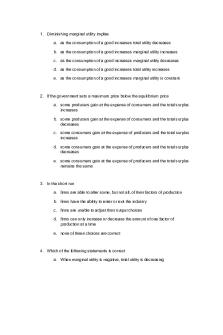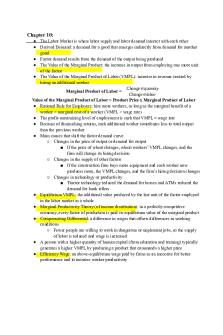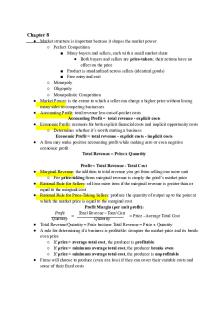Micro Econ Chapter 10 Lecture Notes PDF

| Title | Micro Econ Chapter 10 Lecture Notes |
|---|---|
| Course | Intro To Microeconomics |
| Institution | Indiana University - Purdue University Indianapolis |
| Pages | 2 |
| File Size | 116.2 KB |
| File Type | |
| Total Downloads | 506 |
| Total Views | 734 |
Summary
Chapter 10:● The Labor Market is where labor supply and labor demand interact with each other ● Derived Demand: a demand for a good that emerges indirectly from demand for another good ● Factor demand results from the demand of the output being produced ● The Value of the Marginal Product: the incre...
Description
Chapter 10: ● The Labor Market is where labor supply and labor demand interact with each other ● Derived Demand: a demand for a good that emerges indirectly from demand for another good ● Factor demand results from the demand of the output being produced ● The Value of the Marginal Product: the increase in output from employing one more unit of the factor ● The Value of the Marginal Product of Labor (VMPL): increase in revenue created by hiring an additional worker Change ∈ quantity Marginal Product of Labor = Change ∈ labor Value of the Marginal Product of Labor = Product Price x Marginal Product of Labor ● Rational Rule for Employers: hire more workers, as long as the marginal benefit of a worker > marginal cost of a worker (VMPL > wage rate) ● The profit-maximizing level of employment is such that VMPL = wage rate ● Because of diminishing returns, each additional worker contributes less to total output than the previous worker ● Main causes that shift the factor demand curve ○ Changes in the price of output or demand for output ■ If the price of wheat changes, wheat workers’ VMPL changes, and the firm will change its hiring decision ○ Changes in the supply of other factors ■ If the construction firm buys more equipment and each worker now produces more, the VMPL changes, and the firm’s hiring decision changes ○ Changes in technology or productivity ■ Tractor technology reduced the demand for horses and ATMs reduced the demand for bank tellers ● Equilibrium VMPL: the additional value produced by the last unit of the factor employed in the labor market as a whole ● Marginal Productivity Theory (of income distribution): in a perfectly competitive economy, every factor of production is paid its equilibrium value of the marginal product ● Compensating Differential: a difference in wages that offsets differences in working conditions ○ Fewer people are willing to work in dangerous or unpleasant jobs, so the supply of labor is reduced and wage is increased ● A person with a higher quantity of human capital (from education and training) typically generates a higher VMPL by producing a product that commands a higher price ● Efficiency Wage: an above-equilibrium wage paid by firms as an incentive for better performance and to increase worker productivity
● The individual labor supply curve shows how the quantity of labor supplied by an individual depends on that individual’s wage rate ● The Rational Rule for Workers: work one more hour as long as the wage is at least as large as the marginal benefit of another hour of leisure ● The Substitution Effect: a higher wage raises the opportunity cost of leisure ○ An incentive to work more ● The Income Effect: a higher wage rate makes you richer ○ An incentive to work less and buy yourself more leisure...
Similar Free PDFs

Chapter 10 - Lecture notes 10
- 17 Pages

Chapter 10 - Lecture notes 10
- 9 Pages

Chapter 10 - lecture 10 NOTES
- 14 Pages

Notes - Lecture - Chapter 10
- 3 Pages

ECON-21 - Lecture notes 1-10
- 8 Pages

Micro #2 - Lecture notes
- 19 Pages
Popular Institutions
- Tinajero National High School - Annex
- Politeknik Caltex Riau
- Yokohama City University
- SGT University
- University of Al-Qadisiyah
- Divine Word College of Vigan
- Techniek College Rotterdam
- Universidade de Santiago
- Universiti Teknologi MARA Cawangan Johor Kampus Pasir Gudang
- Poltekkes Kemenkes Yogyakarta
- Baguio City National High School
- Colegio san marcos
- preparatoria uno
- Centro de Bachillerato Tecnológico Industrial y de Servicios No. 107
- Dalian Maritime University
- Quang Trung Secondary School
- Colegio Tecnológico en Informática
- Corporación Regional de Educación Superior
- Grupo CEDVA
- Dar Al Uloom University
- Centro de Estudios Preuniversitarios de la Universidad Nacional de Ingeniería
- 上智大学
- Aakash International School, Nuna Majara
- San Felipe Neri Catholic School
- Kang Chiao International School - New Taipei City
- Misamis Occidental National High School
- Institución Educativa Escuela Normal Juan Ladrilleros
- Kolehiyo ng Pantukan
- Batanes State College
- Instituto Continental
- Sekolah Menengah Kejuruan Kesehatan Kaltara (Tarakan)
- Colegio de La Inmaculada Concepcion - Cebu









